I have touched very briefly on Wapping Old Stairs in a previous post, when I went for a walk along Wapping High Street and Wapping Wall. I am returning to the stairs as when working through the photos my father had taken on a boat trip along the Thames in August 1948, I found one of Wapping Old Stairs and the adjacent Oliver’s Wharf.
I tried to take a photo of the same view when out on the river a couple of months ago, but failed completely to get as good a photo as the one above.
The following photo is the area today. Oliver’s Wharf is the building on the right, the stairs are to the left of Oliver’s Wharf.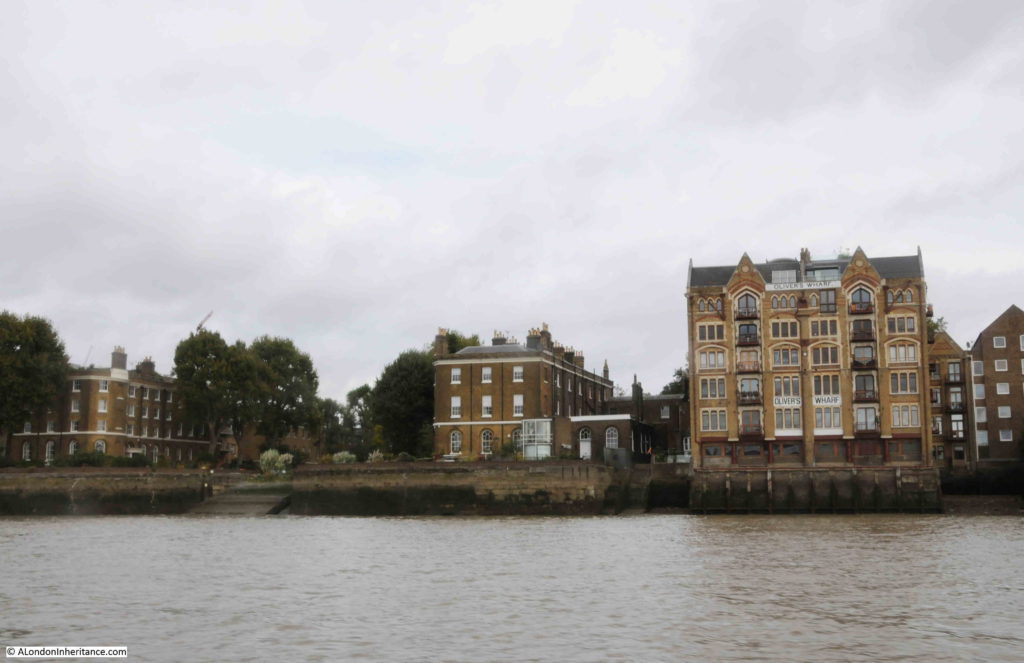
What I love about these photos is that they frequently show people, often children, on the stairs (for example, see the post on Emerson Stairs), and this includes the photo of Wapping Old Stairs, see the following enlargement from the original which shows two children at the bottom of the stairs.
Wapping Old Stairs are – old. There is the possibility that stairs at this location date back to the 16th century or earlier. The first newspaper reference I can find is from the 12th August 1736 when “The Body of a young Man well dressed, with a Watch and a Sum of Money in his Pockets, was taken up floating at Wapping Old Stairs: Upon fetching him he appeared to be an Apprentice belonging to Mr. Stilton, a Currier in Bermondsey-street; but by what Means he came drowned is very uncertain.”
This report confirms that in 1736 they were called the “Old” stairs. This part of the name was used to separate these stairs from another set of stairs built slightly to the east along the river, which were called Wapping New Stairs (these can also be found today).
The following extract from the 1896 Ordnance Survey Map shows Oliver’s Wharf and Wapping New Stairs to the left of the map, just before the Wapping Entrance to Wapping Basin of the London Docks. Towards the right of the map are Wapping New Stairs, just by Old Aberdeen Wharf.
Credit: ‘Reproduced with the permission of the National Library of Scotland’
So presumably Wapping Old Stairs were the original stairs, and Wapping New Stairs came latter, with the old and new being added to uniquely identify the stairs. This method of identifying stairs can be found in the names of a number of Thames stairs, for example I have already written about Horselydown Old and New Stairs.
Despite being called “New”, Wapping New Stairs are also old, and I found a newspaper reference to them a couple of years before that for Wapping Old Stairs, when, from the 28th December 1728:
“On Monday, between one and two in the Morning, a Fire was discovered at the Waterman’s Arms Ale-House near Wapping New Stairs, and by timely assistance was quenched, having only burnt some Apparel and a Chest, on which the Servant Maid of the House had stuck a Candle, but had fallen asleep and left it burning.”
The number of fires in the timber buildings along the river was considerable, and a regular occurrence. In the same newspaper was another report of a fire at the nearby Gun Dock:
“Yesterday Morning early, a Fire broke out at a Hatter’s near Gun Dock in Wapping, which in a short space consumed the same, and three other Houses adjoining to it: In one of the Houses a Man and three Women went upstairs to save some Goods, but were prevented by the Flames from getting down again: one was saved by escaping over the Tops of some Houses, and the three Women flung themselves out of a Window into the street but one of them (a Servant Maid) pitched on her Head and died on the Spot.”
Both stairs therefore date from at least the early 18th century, with Wapping Old Stairs almost certainly being of a much earlier date.
Both stairs also feature on the 1746 Rocque map. The following extract shows Wapping Old Stairs to the right of the map (the new stairs are also on the map, but on a separate page in my copy of Roque’s maps).
Thames stairs provide a useful geographic reference point to events on the river, and newspapers from the early 18th century onward are full of reports of bodies being found, arrivals and departures, crime, lost goods, arriving and departing ships etc.
One report from the 28th October 1738 gives an idea of the types of exotic goods that were arriving at Wapping in the 18th century:
“On Saturday Mess. Wills and Fleming, two Tide Surveyors, found 200 lb of Venice Glass at Wapping Old Stairs, which were sunk in the River in three Bags, fix’d to two Boat-Hooks very artfully. ‘Tis a rich Capture.”
I suspect that 200 lbs of Venice Glass would indeed be a rich capture. What the report does not help with is why they were in the river – lost while transferring from river to land, or perhaps hidden in the river by a thief, ready for later recovery.
Thames river stairs are rich sources of history for that part of London that forms the boundary between river and land (see my post on Life and Death at Alderman Stairs, where I explored in more detail the history of one set of Thames stairs).
Wapping Old Stairs also probably has more cultural references than the majority of other river stairs.
Wapping Old Stairs was the title of a Comic Opera at the Vaudeville Theatre in 1894:
The St. James’s Gazette review of the play, which had a rather serious subject for a comic opera:
“The author and composer of ‘Wapping Old Stairs’, the new opera or operetta produced at the Vaudeville on Saturday night, may be congratulated on having achieved a genuine musical and dramatic success. There is but little of the spectacular element in the piece; the same set scene does duty throughout, and almost the only dresses are those of sailors and of their constant associates, ‘the merry maids of Wapping’. The eminent musician in using for his score the old melody of ‘Wapping old Stairs’ , which might have been treated with dramatic effect.
Mr Stuart Robertson’s book, with but little dramatic basis is ingeniously constructed, and his lyrics are written with grace and point. It appears that in the last century, or even earlier, two sailors of Wapping fell in love with the same girl; on which the most unscrupulous of the young woman’s admirers committed a murder, and so arranged matters that his rival was looked upon as the assassin and, to save his life, fled to foreign parts. But after the lapse of many years the truth came out; when the good man returned to the land of his birth and the girl of his heart, while the bad man was executed, and after ‘ suspension by the neck’ hung ignominiously in chains.
This story is, no doubt a little tragic for a comic opera, and the librettist, whilst softening its harsher features, has introduced in abundance the element of mirth.”
The Vaudeville Theatre is probably the nearest that most West End theatre goers would get to the realities of life in 19th century Wapping. The review of the play also comments on the execution by hanging, which refers to the practice of hanging criminals along the river and a number of places, including Wapping Old Stairs have been referenced as “Execution Dock”. I suspect no single site was used and a number of locations along the Wapping riverbank would have been used.
The Tatler in 1903 produced the following print to go with a song written by Charles Dibdin which referenced the stairs:
“Your London girls with all their airs
Must strike to Poll of Wapping Stairs
No tighter lass is going
From Iron Gate to Limehouse Hole
You’ll never meet a kinder soul
Not while the Thames is flowing”
Wapping Old Stairs is reached today, as it has been for many years, by turning off Wapping High Street and walking alongside a pub, which possibly dates back to the 15th Century as the location for a pub. Known from 1533 as The Red Cow, then the Ramsgate Old Town and finally from 1811 as the Town of Ramsgate. This may also date the origins of Wapping Old Stairs as a pub alongside stairs would be ideal for those arriving or departing on the river.
The narrow alley leading to the stairs:
View of the stairs at low tide:
The liquefied mud covering the stairs at low tide does make the stairs a rather risky route down to the foreshore, but once at the bottom, the reward is a superb view along the river. The photo below is the view looking west towards the City. The entrance to what was the London Docks can be seen where the river wall appears to break.
The foreshore is littered with London’s history. Rounded nodules of chalk, once used to provide a flattened base on the foreshore for mooring barges and lighters. The bricks that once built the City and Docks, now broken and worn by a thousand tides.
The distinctive two sets of stairs. I suspect the stairs on the right are the original Wapping Old Stairs, and those on the left were added to provide private access for the buildings on the left, built alongside the entrance to the London Docks.
It was at the base of these stairs that the children were sitting in the 1948 photo. Interesting to speculate on the countless thousand who have arrived or departed along these stairs, transported cargo to and from the river, or just sat here and watched the river.
The small dock space to the right of the stairs is much the same as in 1948.
In the centre of the dock wall, at the point between light and shadow in the above photo is a large round pipe that looks to have been filled, above is a manufacturer’s name:
J. Burton Sons & Waller were Gas, Hydraulic and Sanitary Engineers of John’s Place, Holland Street, Blackfriars, Southwark.
As usual, a brief exploration of part of London’s history, and writing these posts always generates a long list for further research. When were Wapping Old Stairs first used and named, and what part did the stairs play in the development of Wapping. Confirmation of the reason for the double sets of stairs. What did J. Burton Sons & Waller install at Wapping Old Stairs.
For me, the Thames Stairs are where I feel closest to London’s long history in that unique area between the river and the land, and there are many more stairs to explore.


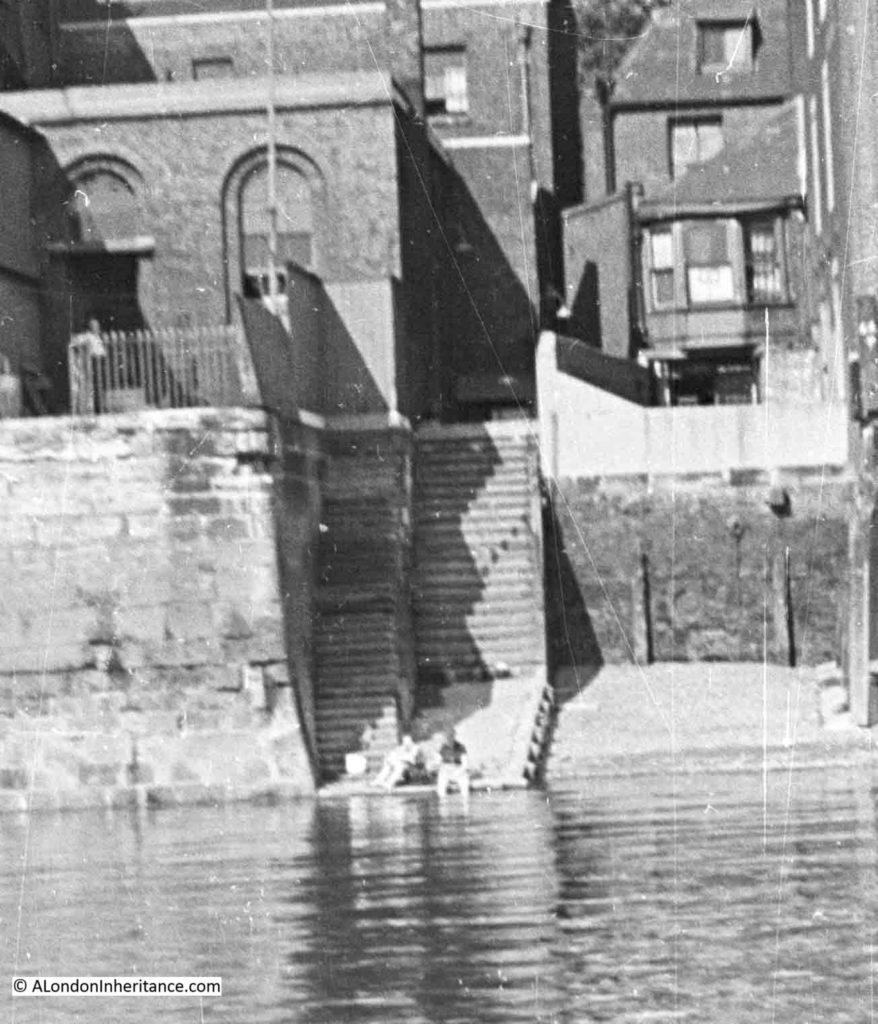

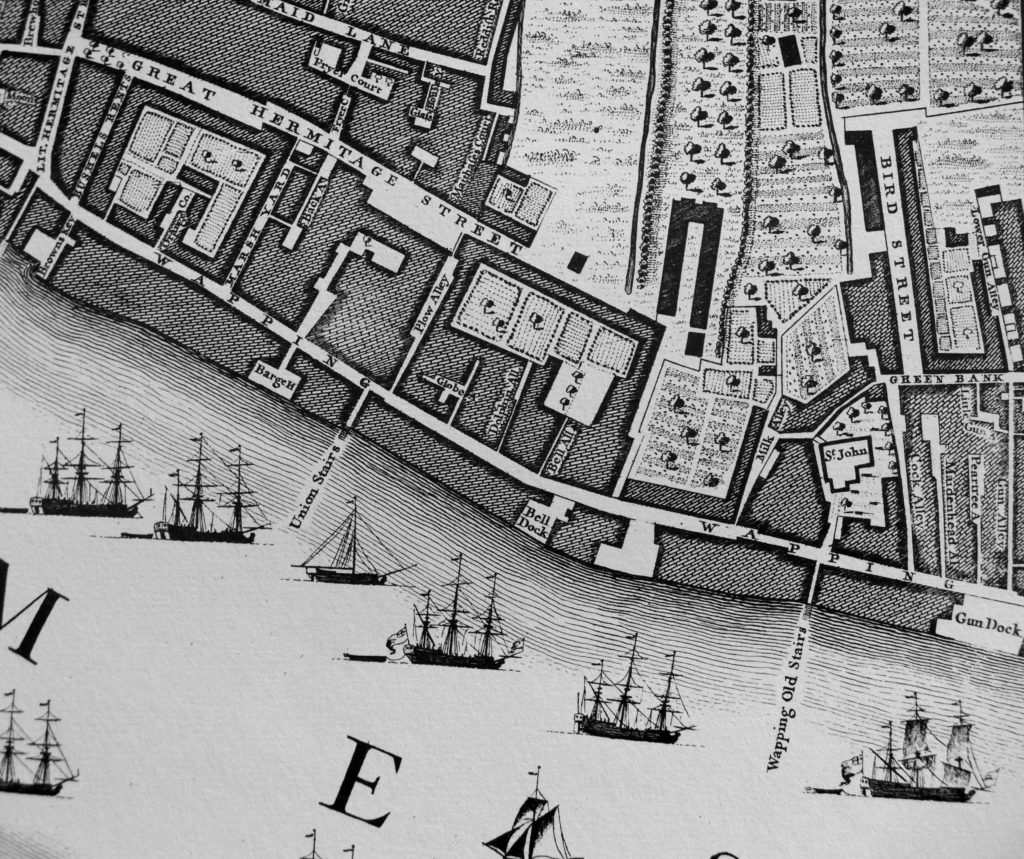
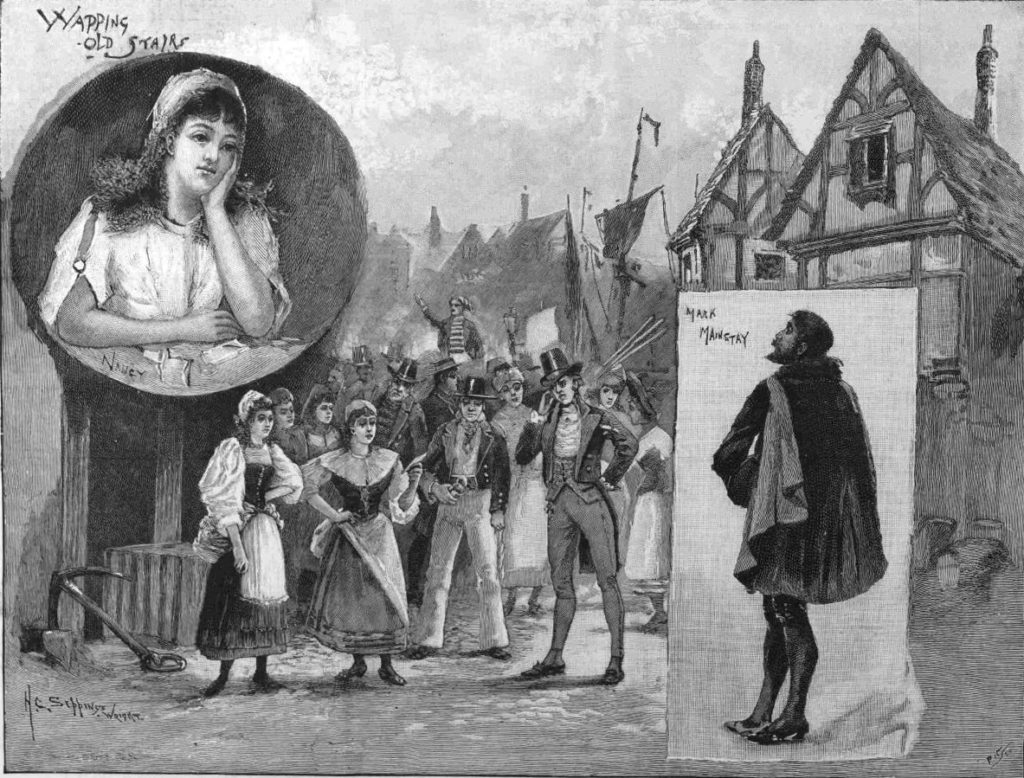
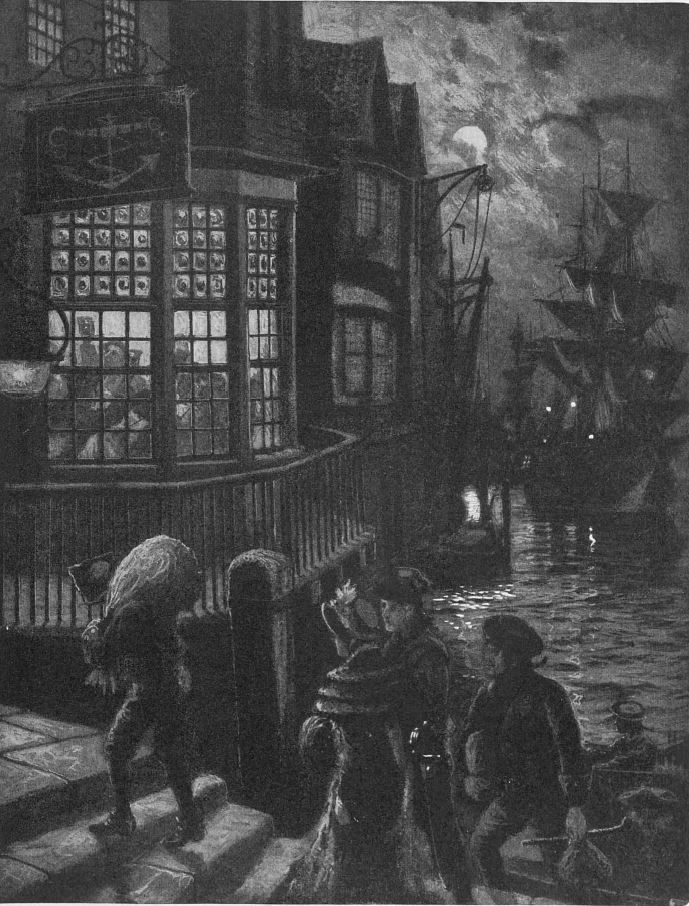

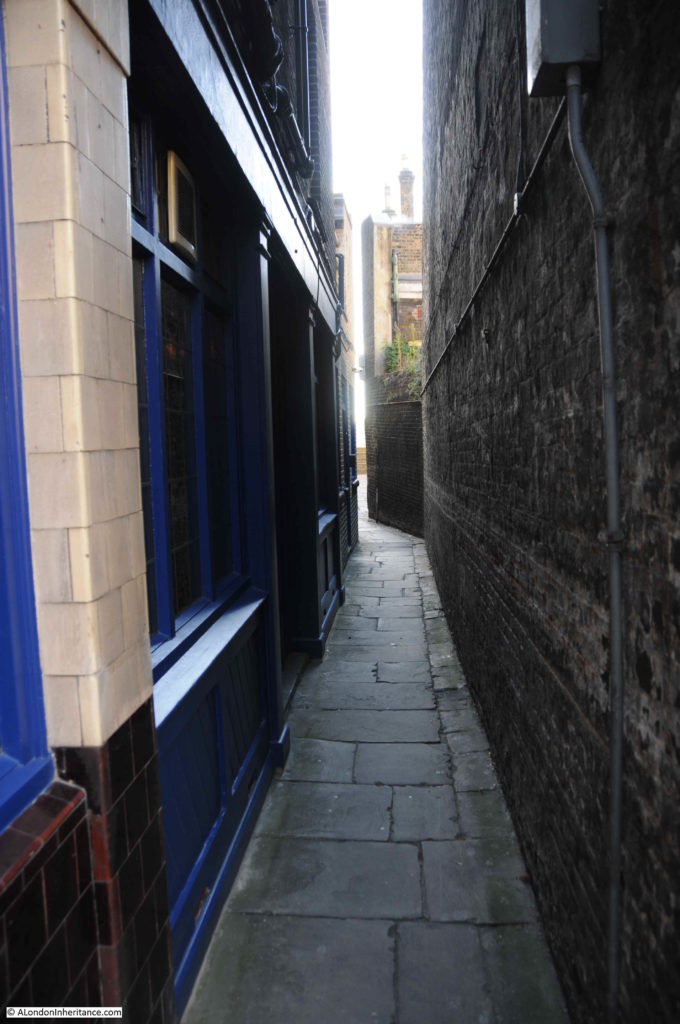

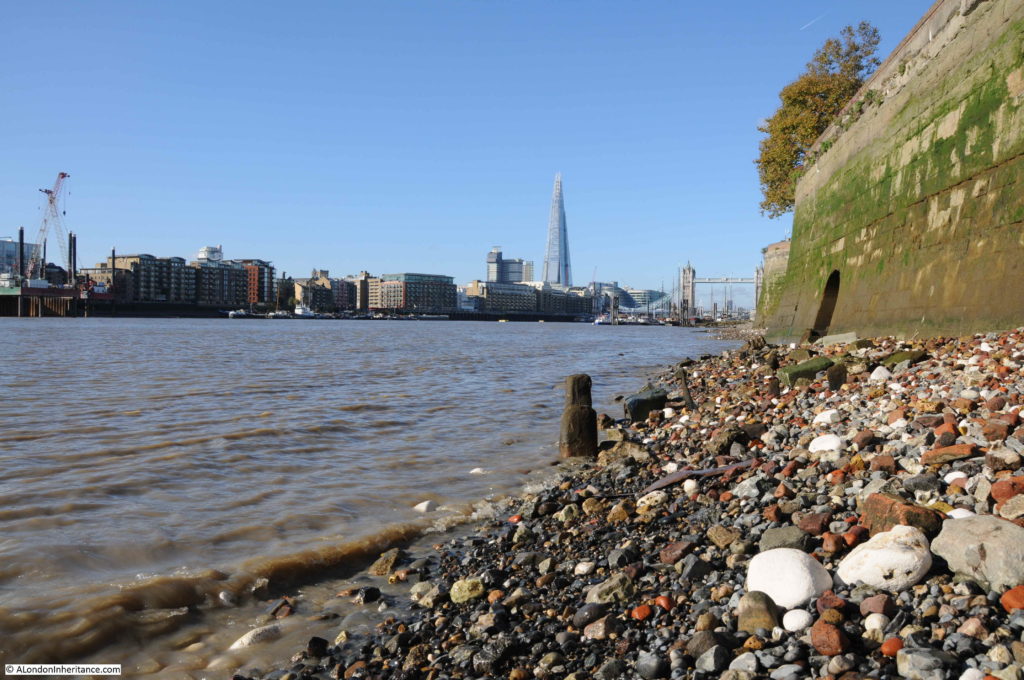
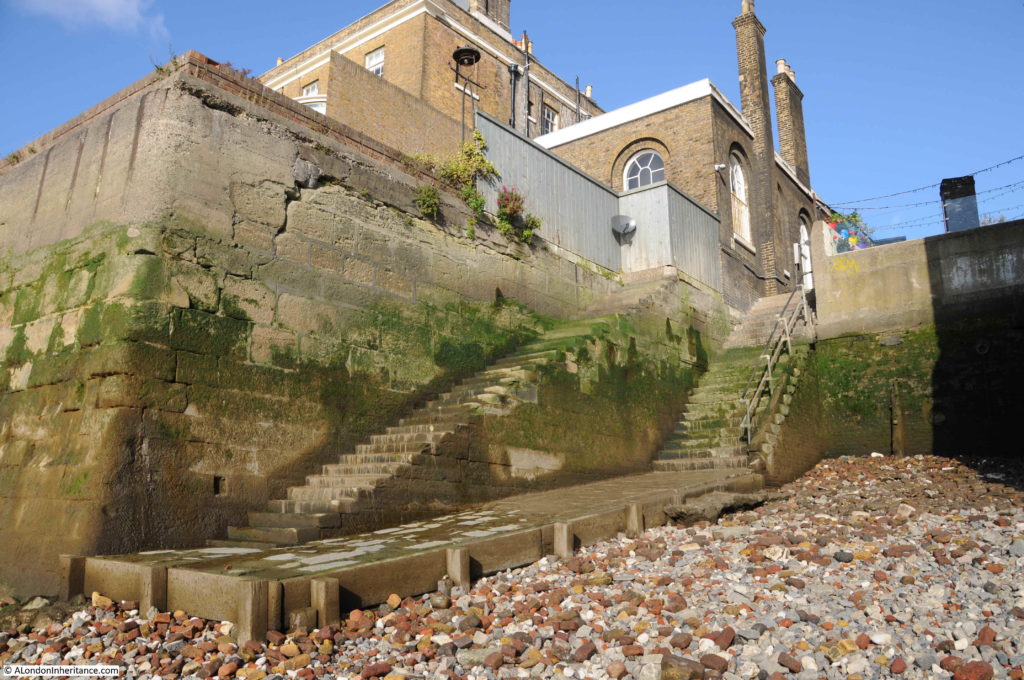
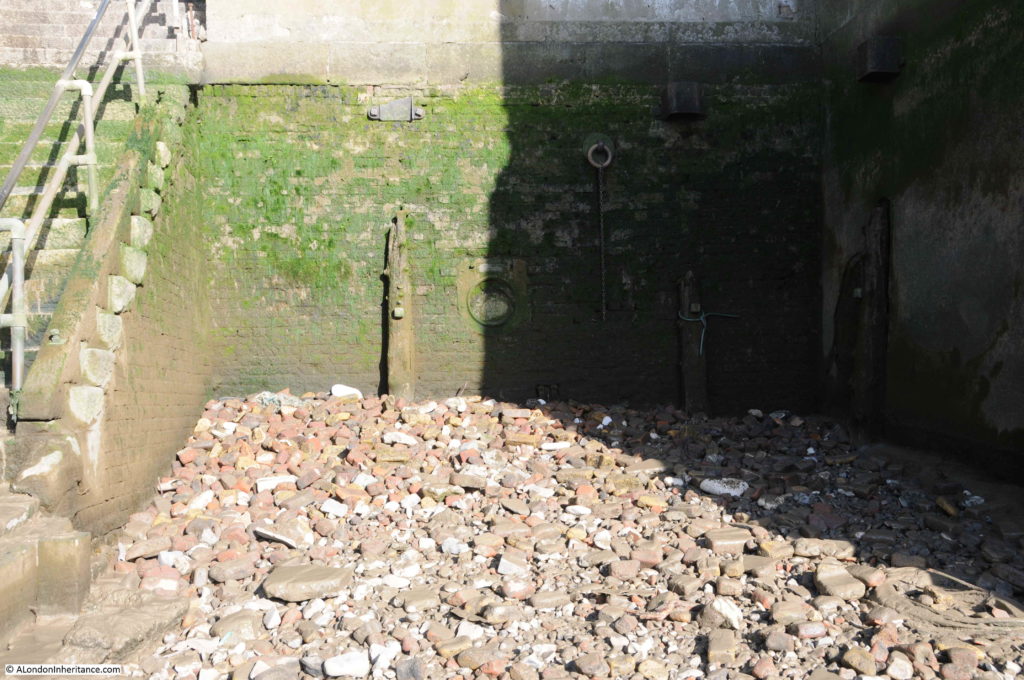

Thank you again for insight into my own family history on the paternal side, a long line of the Wilson Family, Thames lightermen based in Wapping and the surrounding area in the 1800`s and early 1900`s.
From research my cousin found, some ancestors were born in Gun Alley and from the 1746 map can see that it extended from the Gun Dock. I`m sure they played on the Wapping stairs as children as their fathers` etc drank in The Town of Ramsgate pub.
My grandfather (whose father was a lighterman) was been born in Brook Street in 1891, now the eastern end of Cable street.
Thanks for another great article. The reference to Tide Surveyors is possibly to H M Customs as this is a job title along with Tide Waiter (a junior grade) that was common at that time. Both jobs involved boarding incoming ships at Gravesend and accompanying them to their berth to ensure no cargo was smuggled without payment of duties.
At the date that the Venetian glass was hidden, was there was import duty on luxury goods?
If so, someone might have planned to smuggle the glass ashore later, avoiding the excise men.
I have walked down those steps so many times -very evocative area
Love it! Another great review of an historically significant spot that to an unknown traveler could be overlooked. Great photos and written with such appreciation of it’s history and current day presence.
Another brilliant Sunday read !!
My late Dad was born and bred in Wapping and lived in Great Hermitage Street (was it named Hermitage Wall at some time?) for a good number of years.
The old photo’s that you show, remind me of Dad’s tales of bygone days, one was that you would never see any Jews or Police in Wapping !! Apparently, the Jews were “dealt with” and whenever the River Police brought their boats too close, then they would be showered with bricks!!
I really must find the time to explore the area.
Thank you again for these marvellous posts. I’ve found an oyster shell around there and wondered about its history
Thanks for the great article that so reminded me about part of my Wapping childhood. My brother and I played in and around the stairs as young lads right after the end of WW2. We lived on Watts St not far away and were always on the lookout for “treasure.” 😉
Thanks for this brilliant post, as always your research is fascinating. I write novels set in Bermondsey and always try to include at least one scene by river stairs – in various novels I’ve had a murder, attempted suicide, a marriage proposal and plenty of children mudlarking! My forthcoming book THE BERMONDSEY BOOKSHOP is set in East Lane, Bermondsey and many scenes are set around the East Lane river stairs. Unfortunately haven’t been able to find a close up photo of the stairs, but I imagine they would look a lot like the Wapping Old Stairs.
Lovely piece
John Lucy is likely to be mistaken in imagining that the police steered clear of Wapping since they have had the base of the river police located there for more than a century. In fact I think even Dickens mentions the police being there when a body is found nearby in Bleak House.
Thank you so much for these snippets of London history, well done to your father for taking these photos and you for following them up, I really enjoy them. Mel
Thanks for the information.
I was going through family history and came accross the interesting note:
Sir William Winter, father of Sir Edward Winter, father of John Winter, had bought the wharf at Wapping on 25 April 1573, as recorded in Close Roll 2555, together with Christopher Baker, the father of Tomas Baker. The profits were to be shared between Sir William Winter and Christoper Baker.
John Acworth and Richard Baker (son of Thomas Baker) made a new aggreement with John Winter of Lydney (Sir Williams grandson) whereby John Acworth seems to have taken over the Wapping Wharfs. More detail at https://www.wikitree.com/wiki/Acworth-63
It seems that the steps could date back to the 16th Century.
Thanks. Great article. Just watching the film The Hideout on TV which mentioned the old stairs and wanted to know more about them.
Same here!
seems our family could own this site as a lease agreement was made by jon acworth in 1600s with thiomas baker all at kew ian acworth seen documents and veryfied them on wiki where do we stand now can we claim this?
It may be of interest to know that it was at Wapping Old Stairs in the spring of 1787 that a small merchantman was berthed and up for sale by her owners, Messrs. Wellbank, Sharp and Brown. It was a common ship at the time, when Britain had the largest fleet of merchant ships in the world. Her name was Bethia, and she was sold in that year to the Navy Board for the sum of £1,950.00. In May she was moved to Deptford Yard for fitting out for a voyage to the South Seas. In June the Admiralty instructed the Navy Board to have Bethia registered on the Royal Navy Ships List as HM Armed Vessel Bounty. On 16 August the Post Captain was appointed to command the vessel for its voyage. His name was Lieutenant William Bligh.
Burton sons & waller , were around as the same time as Bazalgette was undertaking the major sewage/drainage systems following the great stink . They made pen-stocks,flushing gates and tidal flaps.the Wapping one is certainly a tidal flap to stop water going back from the river into the discharge pipe
While researching my Whitby and North Yorkshire Quaker ancestry, I discovered that Katherine Lotherington, my 7x great-grandaunt (1697-1782) left North Yorkshire after her marriage to Solomon Fossick (1793-1756) and went to live in Wapping. Solomon and some of his brothers had been apprenticed in various trades in the Wapping area. Their father, a yeoman farmer paid the apprenticeship fees. He had several sons and other than agricultural work, weaving, or flax dressing the choices of employment were limited in the countryside near Thirsk.
Solomon, a cheesemonger was living on Wapping High Street near Wapping Old Stairs and it proved to be a very unhealthy environment. Katherine gave birth to 9 children, but only 2 lived to adulthood, the rest died as infants or young children.
There must have been an active Quaker presence in the area as all the births and deaths are well documented and witnesses and midwives named. Certain Quaker members would visit the families of a deceased person and report on the causes of death at the next meeting. In 1733 alone, Katherine and Solomon buried 3 children aged between 1 year and 4 years of age who died of smallpox. From 1738 three more tiny daughters died of smallpox or unspecified fever. Some of the Quaker records actually give their address as King Edward’s Stairs, Parish of St. John. I assume that their home was very close to the photo taken by your father and known as Wapping Old Stairs.
All the children and family members were buried at Ratcliff Quaker Burial Ground.
On another page, you mention John Warner (1674-1760), a horticulturist who had a large Thameside garden and discovered that he was able to grow Beaujolais grapes against brick walls; developing a productive vineyard- the first of its kind in Britain. He also grew pineapples and other exotic fruit. I have more information on his garden.
John’s descendant- Mehetabel Warner married Robert Fossick- one of the 2 surviving children of my 7x great-grandaunt, Whitby-born Katherine Lotherington, and her husband Solomon Fossick who was originally from near Thirsk, North Yorkshire.
Despite the outbreaks of smallpox, in general, the Fossick family members prospered and made a success of their relocation to Georgian London.
I have very much enjoyed looking at what has been posted. Thank You.
Wrapping Old Stairs
Just watching an old film call The Hideout they mentioned a meet at. “Wrapping Old Stairs “
I asked Alexa and your article came up
Very interesting
Cheers
Colin